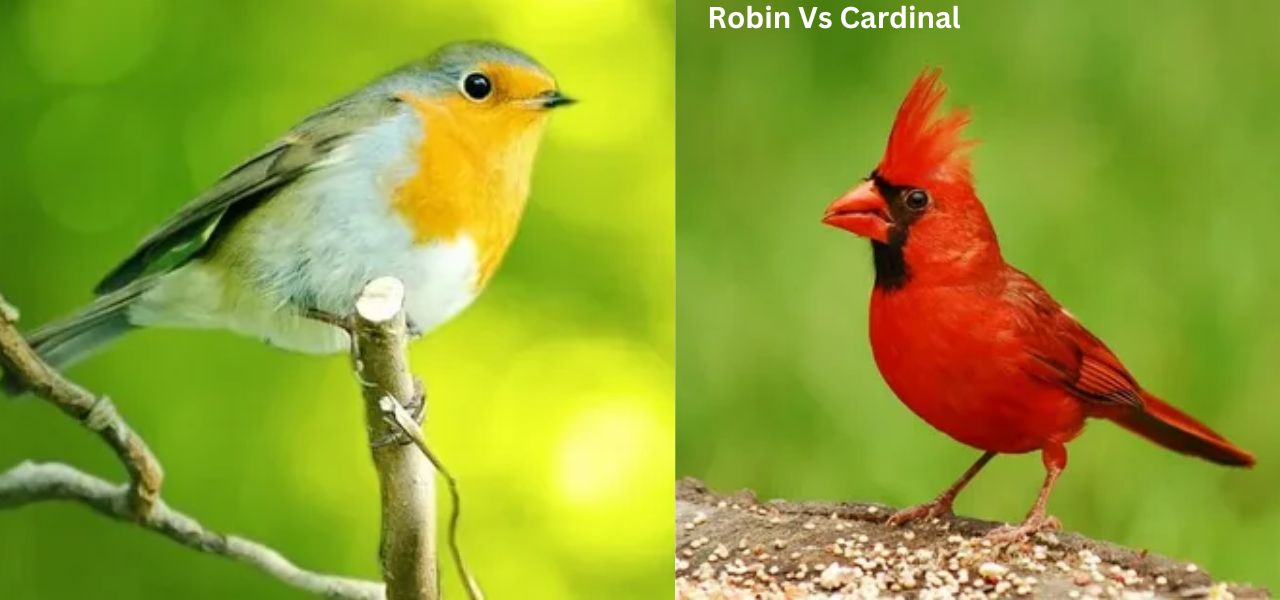Robin Vs Cardinal: Explore the Backyard Bird Battle
In the great robin vs cardinal showdown, both birds bring their unique charm to our backyards. The American Robin, recognized by its distinct orange-red breast, is a sign of spring and often seen foraging on grassy lawns.
Measuring around 9-11 inches in length, these agile songbirds are adaptable and thrive in various habitats across North America. They migrate between breeding grounds in Canada and wintering sites as far south as Mexico, ensuring their presence remains felt throughout different seasons.
Differences Between Robins Vs Cardinals

When pondering the robin vs cardinal debate, it’s essential to appreciate their distinct characteristics that make each bird captivating in its own right. One of the most striking differences lies in their plumage.
| Feature | Robins | Cardinals |
| Size | When comparing the robin vs cardinal, one of the first noticeable differences lies in their size and appearance. robins are medium-sized birds with a rounded shape that gives them a plump look, | Cardinals tend to be slightly smaller yet exhibit a more robust physique. |
| Color | The robin’s soft gray back adorned with an orange belly is not only charming but also functional for blending into its natural habitat. | The striking red plumage of male cardinals serves as a vibrant emblem of strength and beauty against treetops and snow-laden landscapes. |
| Beak | The robin’s thin yellow beak is a masterful tool designed for its earthworm hunting exploits, allowing it to deftly pull its prey from soft soils. | The cardinal boasts a strong orange-red beak that symbolizes resilience—it’s perfectly engineered for breaking open tough seed shells, showcasing an evolutionary adaptation that reflects its habitat preferences. |
Their Unique Songs

The songs of robins and cardinals are distinct yet compelling in their own rights, offering listeners a symphony of nature that captivates the senses. The American robin’s melodious tune is often described as cheerful and vibrant, echoing the arrival of spring with its rhythmic phrases.
These clear, whistling notes resonate through the early morning air, signaling new beginnings and warmer days ahead. Their calls can evoke nostalgia for many who associate these sounds with childhood memories of playing outside or gentle summer evenings.
The cardinal’s song strikes a powerful chord with its sharp, clear tones that cut through background noise, making it one of nature’s unmistakable sounds. The male cardinal boasts a diverse repertoire filled with whistles and trills that convey not just territory but also complex emotional states during courtship.
Where Do They Live

The habitats of the red robin and cardinal highlight their behavioral differences. The eastern red robin thrives in open woodlands, gardens, and parks across North America, where it forages for insects and fruits. In contrast, cardinals prefer denser habitats like forests and shrublands, adapting well to suburban areas. For more information on various bird species, you can check out this link on crested woodland birds.
- The cardinal prefers dense shrubs and tangles of vines in subtropical forests, often found near water sources. This selection reflects their different feeding habits;
- The robin actively searches for worms or berries on open ground, cardinals use their strong beaks to crack seeds hidden within thick brush.
- As we delve deeper into robin vs cardinal, it’s fascinating to note how urbanization impacts these birds differently. Red robins have adeptly adapted to city life, often spotted hopping around lawns or exploiting gardens for food resources during warmer months.
- On the other hand, cardinals seem more cautious about venturing into heavily populated areas; they tend to favor quieter suburban locales with ample natural cover.
Fun Facts Alert!
When we dive into the vibrant world of birds, the showdown of robin vs cardinal brings forth an array of fascinating insights. Both species, with their striking colors and delightful songs, capture the imagination of bird watchers everywhere.
- The red robin, known for its smooth reddish-orange breast and cheerful demeanor, is often seen hopping around backyards in search of worms or berries.
- The cardinal delights enthusiasts with its bold crimson plumage and distinctive crest—a true symbol of elegance in avian form.
- While both these beautiful birds thrive across North America, their behaviors offer a delightful contrast. The red robin is more social; you’ll usually find them in flocks during migration or feeding times.
- Cardinals are quite different; they’re territorial and often engage in melodious singing to mark their space.
This leads to intense moments as male cardinals showcase their bright feathers to impress potential mates while overshadowing any would-be competitors truly a masterclass in avian display! Whether you’re rooting for the charming red robin or captivated by the persistent cardinal, experiencing their antics can transform any simple park visit into a remarkable celebration of nature’s wonders in this vivid rivalry: “red robin vs cardinal.”
Making Their Nests

When it comes to making their nests, the red robin and cardinal present fascinating contrasts that reflect their unique behaviors and habitats.
- The red robin, with its earthy-toned plumage, often opts for a simple and unadorned nesting approach. They typically construct their nests using grasses, mud, and leaves in sheltered locations such as shrubs or low trees. This pragmatism not only offers a sturdy home for the young but also provides camouflage against potential predators.
- Cardinals take pride in their architectural finesse when creating nests. Known for their striking crimson color, these birds exhibit more elaborate nesting habits by incorporating a diverse array of materials—like twigs and even human-made items like string or paper—into their cozy abodes.
- Their choice of nesting spots is also strategic; they prefer dense foliage for better protection during the critical early stages of rearing young chicks. As we dive into this robin vs cardinal debate on nest-making styles, it’s clear that both species have adapted distinct strategies that suit their environments while showcasing the marvels of avian life.
Helping Them Thrive

In the fascinating world of nature, the vibrant red robin and the striking cardinal symbolize resilience and beauty. By examining robin vs cardinal, we gain insight not only into their differences but also into how both species embody the concept of helping them thrive in their environments. For more intriguing insights into various bird species, you can check out this link on how much a loverbird costs.
The red robin’s adaptive foraging strategies allow it to flourish in a variety of habitats, while the cardinal’s melodic song serves as an essential tool for communication, enhancing its chances of survival. This interplay between behavior and habitat highlights how adaptability is crucial for developing thriving populations.
Observing these two birds reminds us that thriving isn’t solely about individual success; it’s often about community dynamics. Cardinels flock together during winter, illustrating a strategy that helps them endure harsh conditions as they work collectively to find food sources.
Final thought:
In the captivating showdown of Robin vs. Cardinal, backyard bird enthusiasts are treated to a vivid display of personality and behavior. While robins charm us with their cheerful songs and inquisitive nature, cardinals captivate with their striking plumage and bold presence. Observing these two species can enhance our appreciation for the diversity of avian life that graces our gardens and parks. Whether you’re rooting for the vibrant cardinal or the melodious robin, each bird adds its unique flair to our outdoor spaces. So grab your binoculars, head outside, and immerse yourself in the enchanting world of backyard birds!
FAQs:
What is the size of a red robin?
A red robin typically measures about 9 to 11 inches in length, with a wingspan of around 12 to 16 inches.
Why is the bird called robin?
The name robin derives from the Old French word robine, which means little redbreast. It refers to the distinctive red-orange breast of these birds.
What is the habitat of a cardinal?
Cardinals thrive in wooded areas, gardens, and shrubs, often found in residential areas across North America.
Do cardinals migrate?
Most Northern Cardinals are non-migratory and remain in their territory year-round, although some may move short distances for food or shelter.
- Blue Footed Booby Bird: Nature’s Vibrant Diver - November 21, 2024
- Chickens With Hair on Their Heads: The Fascinating World of Feathered Fowl - November 20, 2024
- Green Winged Teal: A Comprehensive Guide to This Fascinating Duck - November 19, 2024







